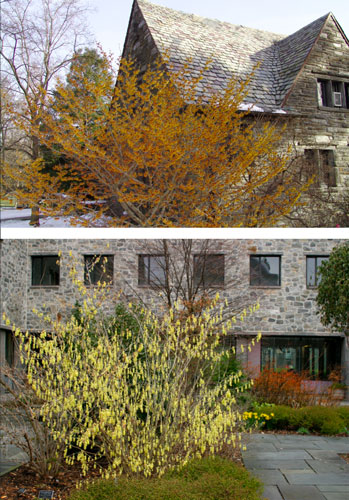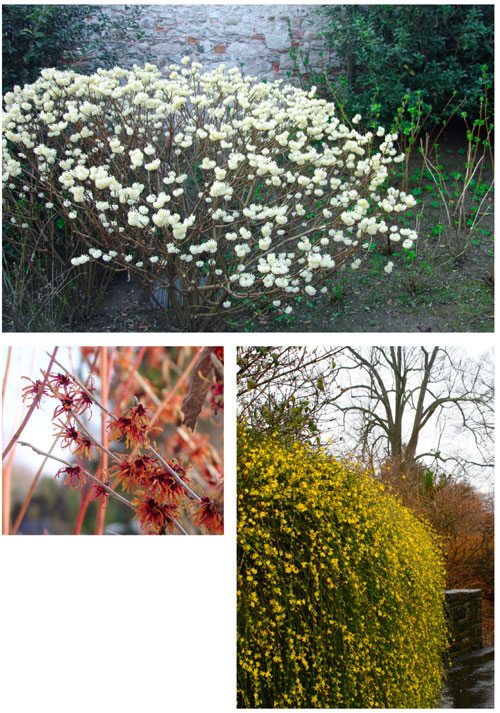8/1/2023
Jewels for the Winter
Andrew Bunting

As I’ve developed my home garden in Swarthmore, Pennsylvania, I’ve been increasingly mindful of winter interest. Over the years, I’ve added many different broadleaved and coniferous evergreens that bring ornament and architecture to an otherwise drab winter landscape. However, most of my winter interest comes from winter flowering shrubs.
Edgeworthia chrysantha has become increasingly hardy in USDA Zone 7 due to warmer winters. It regularly puts on an unequaled late winter floral display. This relative of the daphnes has robust clusters of silvery-white, velvety clusters of flowers that are set in the fall, are ornamental all winter long and can reach 7-ft. tall with an equal spread. In late winter, each cluster has dozens of pendant tubular flowers with a sweet fragrant. In the summer, it has strap-like leaves that add a tropical effect to the garden.
Pictured: Hamamelis x intermedia Jelena • Corylopsis sinensis
var. calvescens
Tim Boland, Director of the Polly Hill Arboretum on Martha’s Vineyard, comments, “I love this plant in many different stages. Here on Martha’s Vineyard, its gleaming, creamy, white floral buds begin to show color in late January and the yellow flowers are revealed by Valentine’s Day.”
Hardy from USDA Zones 7 to 9, it’ll thrive best in full sun and well-drained soil. Snow Cream is a creamy- yellow selection and Akebono (syn. Red Dragon) has orange-red flowers, but is smaller and doesn’t have the same vigor as E. chrysantha.
Let’s Talk Witch Hazels
Over the last 35 years, I’ve observed and grown a fair number of witch hazels, and in the last 20 years, many new cultivars have become available in garden centers and nurseries. Without a doubt, one of the very best is Hamamelis x intermedia Jelena. In mid- to late-winter, this broad spreading, vase-shaped shrub can reach 15-ft. tall and has an abundance of coppery orange, fragrant, strap-like petals that are twisted and slightly crimped. The amazing color of these flowers combines beautifully with the orange winter fruits of Ilex verticillata Winter Gold and the salmon-colored stems of Cornus sericea Cardinal.
Strawberries and Cream is a newer cultivar with flowers that are suffused with yellow, pink and red. These slightly fragrant flowers are also borne in abundance. Like others in the Hamamelis x intermedia group, they exhibit good hardiness thriving in USDA Zone 5 to 8.
There are many excellent witch hazels with yellow flowers. Hamamelis mollis Wisley Supreme is a selection of the Chinese witch hazel, which is one of the most fragrant of the witch hazels and one of the earliest to bloom. Reaching 10- to 15-ft. tall with an equal spread, the abundant golden yellow flowers can emerge as early as January.
Dr. Jared Barnes, Horticulture Professor at Stephen F. Austin University in Nacogdoches, Texas, loves Hamamelis vernalis Amethyst, stating: “It is one of the few witch hazels that will grow well in the Deep South. It starts blooming in late November and continues flowering through January.”
The vernal witch hazel, Hamamelis vernalis, is commonly called the Ozark witch hazel. In the wild, it’s found as an understory plant growing from southern Missouri and northwestern Arkansas into eastern Oklahoma. It’s covered with stout yellow-orange flowers that are intensely fragrant from January to March. Reaching 10- to 12-ft. tall, it can have an amazing spread and will form a large thicket over time. Amethyst has striking reddish-purple flowers. Sandra is noted for its yellow to red fall color.

More Winter Options
A favorite, old-fashioned winter flowering shrub is the Thunberg spirea, Spiraea thunbergii. This rounded shrub has arching branches and is hardy from USDA Zones 4 to 8. All spiraeas grow best in mostly full sun. In mid- to late-winter, this shrub that can reach 6-ft. tall and wide and is covered in a profusion of tiny white flowers.
Pictured clockwise: Edgeworthia chrysantha • Jasminum nudiflorum. • Hamamelis x intermedia Jelena
Mark Weathington, Director of the JC Raulston Arboretum in Raleigh, North Carolina, likes the golden leaf variety, Ogon (syn. Mellow Yellow). As he states, “Wispy bare stems become covered in small white flowers from February through March when the bright golden leaves begin to emerge. The foliage softens to chartreuse-lime over the summer.”
The winter hazels, corylopsis, are highly ornamental shrubs for later winter that will tolerate some shade, but really will have the best vigor in sunny spots in the garden. Mark says about Corylopsis glabrescens var. gotoana March Jewel: “I love all corylopsis, but they can become quite big over time. This one selected at Camellia Forest Nursery stays quite small, about 3 ft. by 4 ft. after 10 years with proportionally smaller leaves. The February/March butter yellow flowers are quite welcome when little else is flowering.”
For its diminutive stature, I also like the buttercup winter hazel, Corylopsis pauciflora. Like other winter hazels, it’s hardy from USDA 6 to 9. In the Mid-Atlantic, it’s covered in soft, butter yellow, fragrant flowers during March. It combines nicely with some of the earlier daffodils. One of my favorites of the winter hazels is Corylopsis sinensis, the Chinese winter hazel, which has stout, upright, zig-zag stems that will reach 10- to 15-ft. tall at maturity. The pendant, golden, fragrant chains of flowers are quite a show.
There are many great jasmines, but by nature, most are vines. Jasminum nudiflorum is neither a vine nor a true shrub. Unlike many jasmines, it isn’t fragrant. In mid-to-late winter, this very twiggy plant is covered in tubular yellow flowers that contrast beautifully against the forest green stems. It’s best displayed when planted on top of a wall where the very long stems can spill over. I’ve seen it planted on top of a retaining wall, where the long green stems cascade downwards and it becomes a very effective screen. The stems can be as long as 15- to 20-ft. and are impactful year-round, especially in the winter when they’re covered in yellow flowers. GP
Andrew Bunting is the Vice President of Horticulture for the Pennsylvania Horticultural Society, which uses horticulture to advance the health and well-being of the Greater Philadelphia region. Andrew has decades of horticultural experience, ranging from his tenures at public gardens in the U.S. and abroad, as well as a published author, gardening expert and sought-after presenter. To learn more about PHS, or to become a member and support greening initiatives in over 250 neighborhoods, visit PHSonline.org.